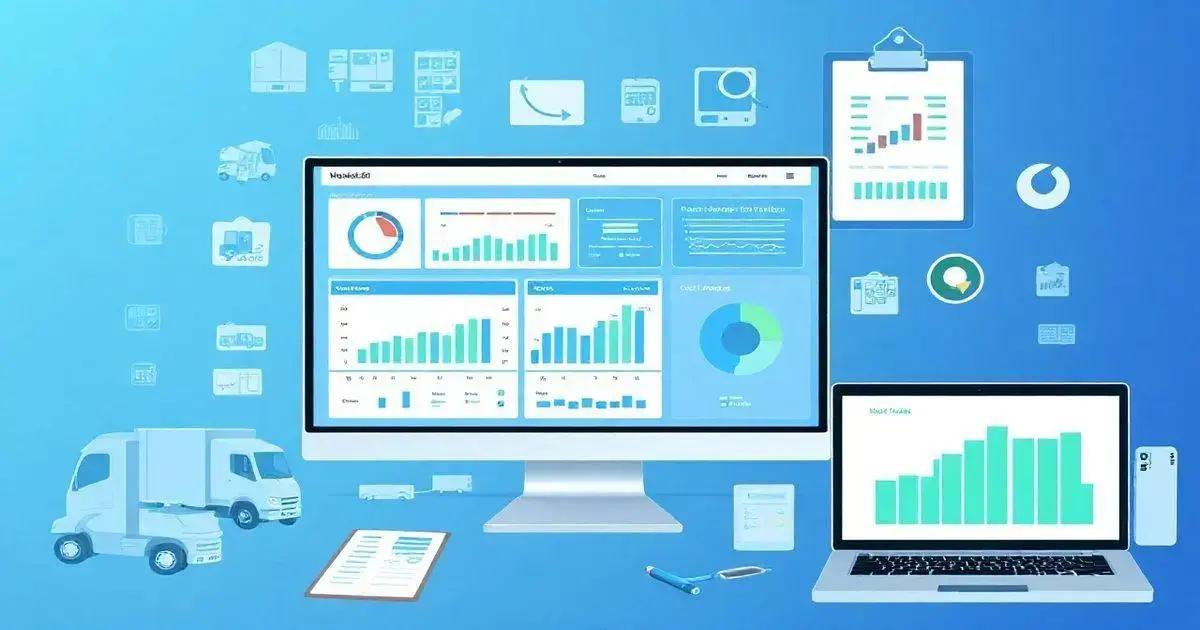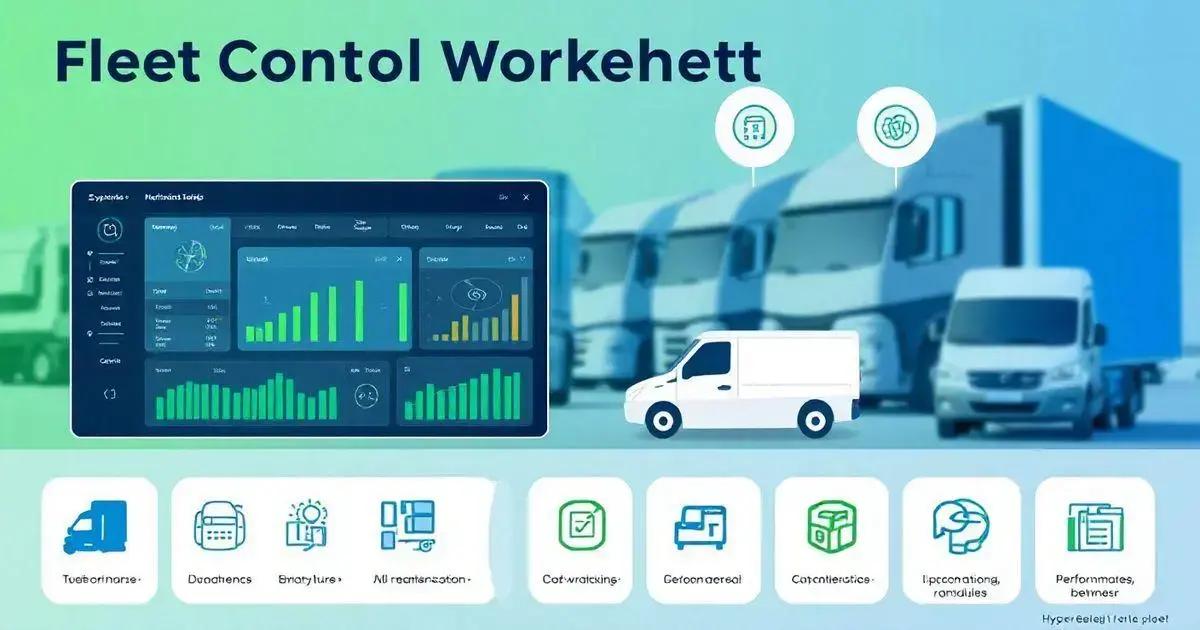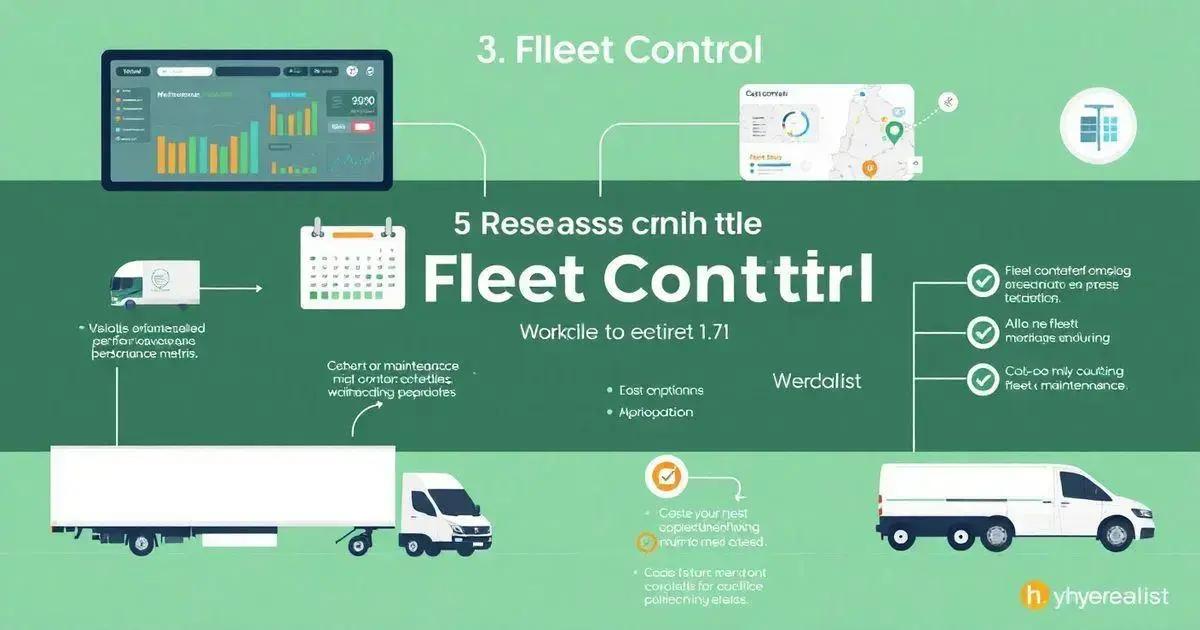5 Essential Features of Fleet Control Worksheet 7.0 Leave a comment
The Fleet Control Worksheet 7.0 is a vital Excel tool for fleet managers, featuring dashboards for driver performance, vehicle usage, and maintenance costs, along with registration and document management capabilities, travel control, tire and maintenance tracking, and the ability to generate yearly analysis reports, all aimed at optimizing fleet operations and improving efficiency.
The Fleet Control Worksheet 7.0 is a powerful tool designed to simplify the complexities of managing a fleet. This worksheet offers a comprehensive approach to tracking vehicle performance, maintenance schedules, and costs.
In this article, we will dive into the essential features that make this worksheet a must-have for fleet managers looking to enhance their operations.
Initial Dashboards Overview
The Fleet Control Worksheet 7.0 comes equipped with several initial dashboards that provide a quick and comprehensive overview of your fleet’s performance. These dashboards are designed to help fleet managers make informed decisions based on real-time data.
KM by Driver: Track the total kilometers driven by each driver, allowing for performance evaluation and accountability.
KM per Vehicle: This feature monitors the distance each vehicle has traveled, helping identify which vehicles are under or over-utilized.
KM per Liter: Calculate fuel efficiency by comparing kilometers driven against fuel consumption, which can help in managing fuel costs effectively.
KM per Trip: Analyze the distance covered for each trip to optimize routes and improve overall efficiency.
Average Consumption per Vehicle: This dashboard gives insights into the average fuel consumption of each vehicle, aiding in maintenance and cost management.
Average Consumption per Driver: Understanding consumption patterns per driver helps in identifying training needs for more efficient driving practices.
Total General, Preventive and Corrective Maintenance: Keep track of all maintenance activities, ensuring that vehicles are serviced on time to prevent breakdowns.
Maintenance Cost Average: Monitor average costs associated with vehicle maintenance, which assists in budget planning and financial forecasting.
Total Cost of Mechanical and Electrical Maintenance: This feature aggregates costs related to mechanical and electrical repairs, providing a clear view of expenditure.
Total Tire Maintenance Cost: Track expenses related to tire maintenance to manage budgets effectively and ensure safety.
Total Lubricant Cost: Maintain oversight of lubricant usage costs, helping to streamline maintenance processes.
Average Cost of Mechanical and Electrical Maintenance: Evaluate the average costs incurred for repairs, allowing for better financial management.
Average Tire Maintenance Cost: Understand the typical costs associated with tire care to anticipate future expenses.
Average Cost with Lubricants: This metric helps in budgeting for lubricant purchases by providing historical cost data.
Vehicles in Transit: Keep track of vehicles currently on the move, enhancing communication and coordination.
Tires in Transit: Monitor tire status during transitions to ensure timely replacements and reduce downtime.
Delayed Vehicle Documents: A dashboard feature that alerts managers to any outstanding documentation issues that may hinder operations.
Delayed Driver Documents: Similar to vehicle documents, this feature ensures that all driver certifications and licenses are up to date.
Delayed Preventive Maintenance: This helps identify any preventive maintenance tasks that are overdue, crucial for vehicle longevity and safety.
Total Cost Versus Shipping: Compare total operational costs against shipping income to evaluate profitability.
Fuel, Maintenance, and Other Costs: A comprehensive overview of all costs associated with fleet operations, essential for strategic planning.
These dashboards not only provide valuable insights but also empower fleet managers to optimize their operations, reduce costs, and improve overall efficiency.

Registration Features
The Fleet Control Worksheet 7.0 includes robust registration features that streamline the process of managing driver and vehicle information. These features are essential for maintaining organized records and ensuring compliance with regulatory requirements.
Registration Features
- Driver Registration: This feature allows for the easy input and management of driver details, including names, contact information, license numbers, and expiration dates. Keeping this information up to date is critical for ensuring that all drivers are legally compliant and ready for duty.
- Vehicle Type Registration: Fleet managers can categorize vehicles by type, such as trucks, vans, or sedans. This categorization aids in maintenance planning and resource allocation based on the specific needs of each vehicle type.
- Mechanical and Electrical Services Registry: This section tracks all mechanical and electrical services performed on each vehicle. By maintaining a detailed log, fleet managers can schedule future maintenance and repairs more effectively, thus preventing unexpected breakdowns.
- Tree Service Registration: This feature allows for the registration of tree service providers, ensuring that the fleet has reliable partners for maintenance and repairs. Keeping a list of trusted service providers can help in quickly addressing vehicle issues as they arise.
- Lubricant Services Register: Track the types and amounts of lubricants used across the fleet. This helps in planning maintenance schedules and managing lubricant costs effectively.
- Register of Workshops and Suppliers: Maintain a comprehensive list of workshops and suppliers that provide parts and services to the fleet. This feature facilitates quick access to contact information and service records, enhancing operational efficiency.
- Expenditure Type Register: This section categorizes all expenditures related to the fleet, such as fuel, maintenance, repairs, and parts. By tracking these expenses, fleet managers can identify areas for cost savings and budget more effectively.
- Refueling Station Registration: Keep a detailed log of refueling stations used by the fleet. This information can help in managing fuel costs and optimizing refueling strategies.
- Fuel Type Register: This feature allows fleet managers to record the types of fuel used for each vehicle, which is crucial for tracking fuel efficiency and compliance with environmental regulations.
These registration features not only enhance the organization of fleet information but also contribute to better decision-making and operational efficiency. By having all necessary data at their fingertips, fleet managers can ensure that their operations run smoothly and effectively.
Document Management Capabilities
The Fleet Control Worksheet 7.0 offers comprehensive document management capabilities that are crucial for maintaining the integrity and accessibility of important fleet-related documents. This feature ensures that all necessary documentation is organized, easily accessible, and up to date.
Document Management Capabilities
- Driver Document Control: This capability allows fleet managers to track and manage all documents related to drivers, such as licenses, certifications, and training records. By having a centralized location for these documents, managers can ensure compliance and avoid potential legal issues.
- Vehicle Document Control: Similar to driver documents, this feature helps manage all vehicle-related paperwork, including registration, insurance, and inspection certificates. Keeping these documents organized and current is essential for legal compliance and operational efficiency.
By implementing these document management capabilities, the Fleet Control Worksheet 7.0 not only enhances the organization of essential paperwork but also mitigates risks associated with missing or outdated documents. This proactive approach to document management helps fleet managers maintain compliance and ensures that all necessary information is readily available when needed.

Travel Control Functionality
The Fleet Control Worksheet 7.0 includes robust travel control functionality designed to enhance the efficiency and oversight of fleet operations. This feature allows fleet managers to monitor and manage all aspects of travel related to their vehicles and drivers.
Travel Control Functionality
- Cargo Control Linked to Trips: This functionality allows for detailed tracking of cargo associated with each trip. Fleet managers can link specific cargo information to trips, ensuring accurate documentation and accountability for goods transported.
- Vehicle Control: Monitor the status and performance of each vehicle during trips. This feature helps in tracking vehicle utilization, ensuring that all vehicles are operating efficiently and effectively.
- Driver Control: Keep tabs on driver assignments and performance during travel. This functionality allows fleet managers to ensure that drivers adhere to schedules and maintain safe driving practices.
- Supply Control: Manage and track supplies used during trips, such as fuel and maintenance items. This feature helps in budgeting and ensures that all necessary supplies are available for successful operations.
- Control of All Travel Expenses: This comprehensive tracking system allows fleet managers to monitor all expenses incurred during travel, including fuel, tolls, and maintenance costs. By analyzing these expenses, managers can identify cost-saving opportunities and optimize budgeting.
Overall, the travel control functionality of the Fleet Control Worksheet 7.0 empowers fleet managers to oversee travel operations effectively, ensuring that all trips are well-documented, expenses are managed, and resources are utilized efficiently. This proactive approach not only enhances operational efficiency but also contributes to improved profitability.
Tire and Maintenance Control
The Fleet Control Worksheet 7.0 provides essential tire and maintenance control features that are vital for ensuring the safety, reliability, and longevity of fleet vehicles. These functionalities help fleet managers keep track of tire health and maintenance schedules effectively.
Tire and Maintenance Control
- Identification for Each Tire: This feature allows fleet managers to assign unique identifiers to each tire, enabling easy tracking of tire history, performance, and maintenance records. This ensures that no tire goes unnoticed and helps in optimizing tire usage.
- Tire Change Schedule by KM: The worksheet includes a scheduling tool that alerts managers when tires need to be changed based on kilometers driven. By adhering to these schedules, fleet managers can prevent tire-related issues and enhance vehicle safety.
- Signal of How Much KM is Left to Change the Tire: This functionality provides real-time updates on the remaining kilometers before a tire change is required. This proactive alert system helps in planning maintenance effectively and minimizing downtime.
- Status per Action: Manage the status of each tire based on actions taken, such as allocation to a vehicle, removal from service, scrapping, or maintenance. This organized approach ensures that fleet managers have a clear overview of tire conditions and actions required.
- Maintenance Control: The worksheet tracks both corrective and preventive maintenance for tires, allowing fleet managers to schedule regular checks and repairs. This feature ensures that all tires are maintained in optimal condition, reducing the risk of blowouts or other tire failures.
- Maintenance by Vehicle: This function allows for tracking maintenance activities specific to each vehicle, ensuring that all tires are properly serviced according to the vehicle’s needs and usage patterns.
By implementing these tire and maintenance control features, the Fleet Control Worksheet 7.0 enhances the overall management of fleet operations. Fleet managers can ensure that tires are in good condition, maintenance is performed on schedule, and safety standards are upheld, ultimately leading to reduced costs and increased vehicle reliability.

Yearly Analysis and Reports
The Fleet Control Worksheet 7.0 includes powerful yearly analysis and reporting features that provide fleet managers with comprehensive insights into their operations. These tools are essential for evaluating performance, identifying trends, and making informed decisions for future planning.
Yearly Analysis and Reports
Here are some key reports available:
- Total Travel: This report aggregates the total distance traveled by the entire fleet over the year, allowing managers to assess vehicle utilization and performance across all trips.
- Cost with Preventive and Corrective Maintenance: Fleet managers can analyze the total costs associated with both preventive and corrective maintenance activities. This report helps in budgeting and identifying areas where maintenance practices can be improved to reduce costs.
- Fuel Consumption: Track overall fuel consumption for the fleet, providing insights into efficiency and identifying vehicles that may require attention due to excessive fuel use.
- Fuel Cost: This report details the total fuel expenses incurred over the year, allowing for better financial planning and cost management strategies.
- KM Run: Analyze the total kilometers run by each vehicle, helping managers understand usage patterns and plan for necessary maintenance or replacements.
- Average KM per Liter: This metric provides insights into the fuel efficiency of the fleet, enabling comparisons between vehicles and helping identify opportunities for improvement.
- KM per Maintenance: Track the average distance traveled between maintenance activities. This report is crucial for optimizing maintenance schedules and ensuring vehicles are serviced at appropriate intervals.
- Total Cost: A comprehensive overview of all costs associated with fleet operations, including fuel, maintenance, and repairs, allowing managers to evaluate the overall financial health of the fleet.
- Full Shipping: This report provides insights into shipping costs and revenues, helping fleet managers evaluate profitability and operational efficiency.
By utilizing the yearly analysis and reports features of the Fleet Control Worksheet 7.0, fleet managers can gain valuable insights into their operations. This data-driven approach enables more strategic decision-making, ultimately leading to improved performance, cost savings, and enhanced fleet management.
Conclusion
The Fleet Control Worksheet 7.0 is an invaluable tool for fleet managers seeking to enhance their operational efficiency and effectiveness.
With its comprehensive features ranging from registration capabilities to travel control, tire and maintenance management, and detailed yearly analysis, this worksheet provides a holistic approach to fleet management.
By leveraging the insights gained from the various dashboards and reports, managers can make informed decisions that lead to cost savings, improved safety, and optimized vehicle performance.
The ability to track and manage all aspects of fleet operations in one place not only streamlines processes but also ensures compliance with regulations.
In a rapidly changing business environment, having a reliable and efficient system like the Fleet Control Worksheet 7.0 is essential for any organization looking to stay competitive and maximize their fleet’s potential.
Embracing this tool will undoubtedly lead to smarter management practices and a more successful fleet operation.
FAQ – Frequently Asked Questions about Fleet Control Worksheet 7.0
What is the Fleet Control Worksheet 7.0?
The Fleet Control Worksheet 7.0 is a comprehensive Excel tool designed to help fleet managers track and manage various aspects of their fleet operations, including vehicle performance, maintenance schedules, and travel expenses.
How can I track driver and vehicle information?
The worksheet includes registration features that allow you to input and manage driver details and vehicle types, ensuring that all necessary information is organized and easily accessible.
What are the benefits of using the travel control functionality?
The travel control functionality helps monitor cargo, vehicle usage, driver assignments, and travel expenses, enabling fleet managers to optimize operations and reduce costs.
How does the tire and maintenance control feature work?
This feature allows for tracking tire identification, change schedules, and maintenance activities, ensuring that all tires are properly serviced and maintained for safety and efficiency.
What kind of reports can I generate with the Fleet Control Worksheet 7.0?
You can generate various reports, including total travel, maintenance costs, fuel consumption, and yearly performance analysis, providing valuable insights into your fleet operations.
Is the Fleet Control Worksheet 7.0 compatible with all versions of Excel?
Yes, the Fleet Control Worksheet 7.0 is designed to work on any version of Excel, including 2007, 2010, 2013, and 2016, as well as on Windows operating systems.

